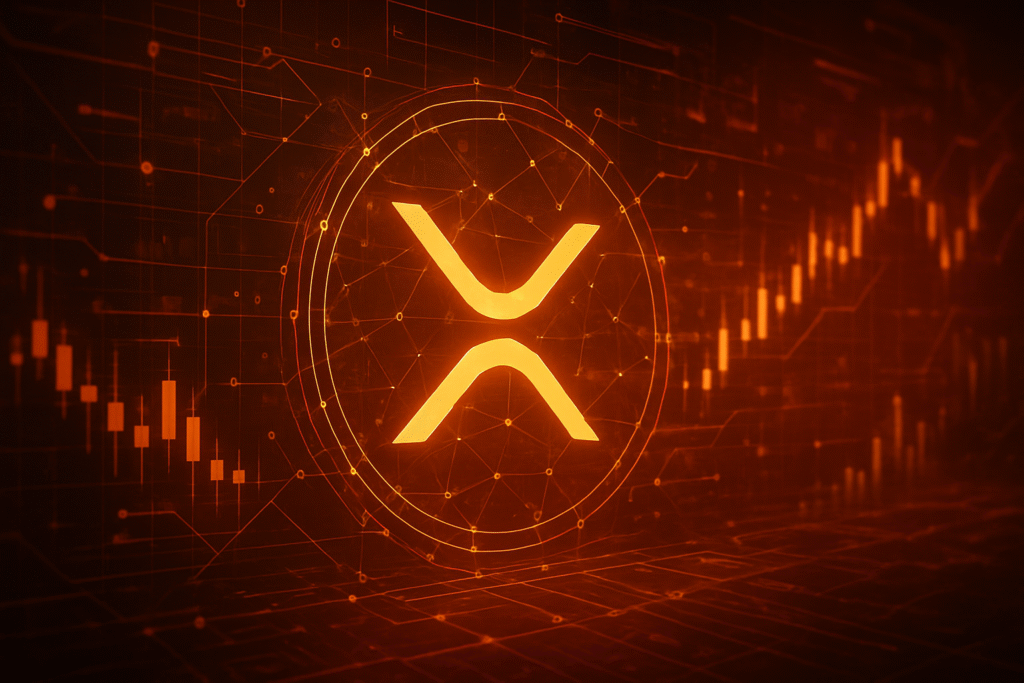Ripple Ignites Wall Street Rivalry with XRP ETF Launch, Eyes JPMorgan’s Throne

The cryptocurrency world is abuzz following a pivotal week that saw the launch of the Bitwise XRP Exchange Traded Fund (ETF) on November 20, 2025, and a bold declaration from a prominent Wall Street CEO. Sal Gilbertie of Teucrium Trading, in a statement made between November 21-23, 2025, asserted that Ripple is strategically positioning itself to become a formidable rival to traditional financial behemoths like JPMorgan (NYSE: JPM). This audacious ambition, underscored by the burgeoning interest in XRP-backed financial products, marks a significant turning point in the ongoing convergence of traditional finance and the burgeoning digital asset ecosystem.
The debut of the Bitwise XRP ETF (NYSE: XRP) on the New York Stock Exchange, hot on the heels of Canary Capital's XRPC ETF on November 13, 2025, has sent ripples across the crypto landscape. Recording an impressive $26 million in trading volume on its first day—making it the third-biggest ETF debut of the year—the event signals a new era of institutional acceptance and accessibility for altcoins. Ripple CEO Brad Garlinghouse himself acknowledged the milestone, proclaiming, "The pre-thanksgiving rush (shall we say turkey trot) for XRP ETFs starts now," highlighting the momentum building around XRP-centric investment vehicles and Ripple's long-term vision to reshape global finance.
Market Impact and Price Action
The immediate market reaction to the Bitwise XRP ETF launch on November 20, 2025, and the subsequent Wall Street commentary has been closely watched, though comprehensive long-term data is still emerging given the recency of these events. On its inaugural day, the Bitwise XRP ETF (NYSE: XRP) impressively garnered approximately $26 million in trading volume, positioning it as the third-biggest ETF debut of the year. This initial performance, occurring amidst a broader crypto market downturn where Bitcoin experienced a dip and XRP's price was reportedly testing critical support levels, underscores a significant investor appetite for direct XRP exposure through regulated channels.
While specific, sustained price movements for XRP (XRP) are still unfolding, the launch of an institutional investment product of this magnitude typically signals a boost in legitimacy and can attract substantial capital inflows. Historically, the introduction of Bitcoin (BTC) futures ETFs in 2021 and spot Bitcoin ETFs in early 2024 has demonstrated varied short-term impacts, often leading to initial price surges followed by consolidation or "sell the news" events. However, the overarching trend has been an increase in market liquidity, institutional participation, and a broader acceptance of the underlying asset. For XRP, the immediate volume suggests a strong initial demand, which could translate into upward price pressure if sustained, especially as other asset managers like Grayscale and Franklin Templeton are poised to launch their own XRP ETFs around November 24-25, 2025.
Technical analysis, while still in its nascent stages post-launch, will focus on how XRP navigates key support and resistance levels established prior to and immediately after the ETF debut. The fact that the ETF launched during a challenging period for the wider market indicates that the initial demand for XRP exposure is robust, potentially establishing a strong new support floor. Analysts will be monitoring for a sustained increase in trading volume and a tightening of bid-ask spreads, which would signify enhanced liquidity and market depth, crucial for an asset aiming for global financial integration. The collective acquisition of millions of XRP tokens daily by ETF issuers, as anticipated by experts, could fundamentally alter XRP's supply-demand dynamics over the medium to long term.
The comparison to previous ETF launches, particularly Bitcoin's journey, provides a roadmap. While initial volatility is common, the long-term effect of regulated investment vehicles has been overwhelmingly positive for asset validation and growth. JPMorgan analysts, prior to these launches, had already projected that XRP ETFs could attract between $4 billion and $8 billion in new assets within their first year, a testament to the anticipated institutional interest and the potential for XRP to become a more integral part of traditional investment portfolios.
Community and Ecosystem Response
The launch of the Bitwise XRP ETF and the bold assertions about Ripple's ambition to challenge JPMorgan have elicited a multifaceted response across the crypto community. On one hand, there's palpable excitement among long-term XRP holders and proponents, who view the ETF as a long-awaited validation and a gateway for institutional capital. Ripple CEO Brad Garlinghouse celebrated the Bitwise launch as a "momentous event," emphasizing its potential to revolutionize global payments. Bitwise CIO Matt Hougan echoed this sentiment, highlighting the simplified access it provides to XRP.
However, the immediate aftermath also saw a degree of frustration and a "sell the news" reaction in XRP's price, which experienced a notable dip below $2, erasing recent gains amidst a broader market downturn affecting Bitcoin and Ethereum. This led to mixed sentiment on social media platforms like X (formerly Twitter) and Reddit. While some crypto pundits like Zach Rector viewed the pullback as a buying opportunity, and Cobb predicted an imminent supply shock for XRP due to ETF demand, many community discussions reflected anxiety as XRP tested critical support levels. Users on Reddit, for instance, expressed concerns that despite legal clarity and ETF launches, XRP remained "stuck," although the overarching long-term bullish outlook persisted for many.
The narrative of Ripple as a "JPMorgan rival" resonated strongly within expert commentary. Sal Gilbertie of Teucrium Trading was particularly vocal, envisioning a "Ripple Bank" that, once fully licensed and operating under clear U.S. regulations, would be the true catalyst for XRP's value surge. He underscored Ripple's disciplined leadership and ISO 20022 compliance as key advantages, highlighting past instances where traditional banks like JPMorgan had actively lobbied against Ripple receiving a federal banking license, implicitly acknowledging the competitive threat.
Despite the institutional excitement around XRP ETFs, the direct, immediate impact on related DeFi protocols, NFT projects, or Web3 applications built on the XRP Ledger (XRPL) has been less pronounced. While the XRPL ecosystem continues to develop its capabilities in tokenized assets and decentralized finance, some reports indicated a "notable pullback in network participation" on the DeFi side, with a reduction in Total Value Locked (TVL) since July. This suggests that while ETFs are opening doors for institutional investment into XRP as an asset, the direct spillover into the XRPL's broader DApp ecosystem may be a more gradual process, or perhaps overshadowed by the prevailing market conditions. However, the long-term expectation among some thought leaders is that XRP ETFs will eventually "give attention to DeFi" on the XRPL.
What's Next for Crypto
The recent launch of XRP ETFs and Ripple's audacious strategy to challenge traditional finance giants like JPMorgan (NYSE: JPM) mark a significant inflection point for the broader crypto market. The short-term outlook for XRP (XRP) is likely to involve continued volatility as the market digests the influx of institutional capital and navigates broader macroeconomic headwinds. While the Bitwise and Canary Capital XRP ETFs have already attracted over $118 million in inflows within days of their November 2025 launches, demonstrating robust institutional interest, a "sell-the-news" reaction could still lead to temporary price fluctuations. However, the sustained demand from these and upcoming ETFs from Grayscale and Franklin Templeton is expected to provide a steady tailwind, potentially pushing XRP past the $2.00 mark in the near to medium term. The shifting investor focus, with altcoin ETFs gaining traction even as Bitcoin and Ethereum ETFs saw outflows, signals a maturing market with diversified institutional appetite.
Looking further ahead into 2026 and beyond, Ripple's ambition to become a "JPMorgan rival" is a long-game strategy rooted in establishing a blockchain-native backbone for global finance. Should Ripple secure a banking license, it would be poised to directly compete with established institutions by offering faster, cheaper, and more efficient cross-border payments, potentially disrupting traditional systems like SWIFT. This competition is already evident in JPMorgan's development of JPM Coin for wholesale payments, indicating a broader trend of traditional finance integrating blockchain solutions.
The long-term implications for the crypto market are profound: continued maturation and institutionalization, with increasing adoption by banks, hedge funds, and asset managers through ETFs and tokenized assets. Regulatory clarity, particularly for stablecoins and DeFi, is anticipated to improve globally, fostering greater confidence and compliance. Stablecoins are projected to become ubiquitous, facilitating not just trading but also traditional financial transactions and cross-border settlements. Bitcoin's role is expected to evolve into a more stable digital gold, while Decentralized Finance (DeFi) is poised for mainstream integration, leveraging AI for risk management and security. Technological advancements like Layer 2 scaling solutions, cross-chain interoperability, and Ethereum's "Fusaka" upgrade in December 2025 are critical catalysts for enhanced efficiency and value capture, potentially leading a market rebound in 2026.
Potential catalysts to watch include sustained inflows into XRP and other crypto ETFs, further regulatory clarity (especially regarding Ripple's banking license), a favorable macroeconomic environment with anticipated Federal Reserve rate cuts, and the accelerating tokenization of real-world assets (RWAs). For projects, strategic considerations include prioritizing real-world utility, robust tokenomics, regulatory compliance, interoperability, and enterprise partnerships. Investors, meanwhile, should focus on portfolio diversification, adopt a long-term horizon for assets like XRP, diligently monitor ETF inflows and macro trends, and conduct thorough research beyond speculative hype. The most likely scenario is a sustained institutional-led bull market, albeit with periods of volatility, as the digital asset ecosystem continues its integration into the global financial landscape.
Bottom Line
The confluence of newly launched XRP ETFs and Ripple's explicit ambition to challenge financial titans like JPMorgan marks a transformative period for the cryptocurrency ecosystem. For crypto investors and enthusiasts, the key takeaways are clear:
- Institutional On-Ramps are Here: Multiple spot XRP ETFs, including Canary Capital's XRPC (launched November 13, 2025), Bitwise's XRP (launched November 20, 2025), and Franklin Templeton's XRPZ (launched November 24, 2025), are now live, with Grayscale's GXRP expected on November 25, 2025. These provide regulated, accessible avenues for both retail and institutional capital, simplifying custody and compliance.
- Strong Institutional Validation: Early inflows, such as Canary Capital's $250 million and Bitwise's $26 million first-day volume, underscore significant institutional interest, further bolstered by Ripple's recent $500 million strategic funding round from Wall Street firms like Fortress Investment Group and Citadel Securities.
- Ripple's Strategic Vision: Ripple is not merely integrating with TradFi but actively building a "21st-century investment bank" and a full-stack institutional financial platform (Ripple Prime, Ripple Payments, Ripple Custody, RLUSD stablecoin), directly positioning itself against legacy players like JPMorgan.
- XRP's Evolving Utility: Beyond speculative trading, XRP's fundamental utility in fast, low-cost cross-border payments and as a bridge asset for tokenized assets and stablecoins is increasingly recognized, driving long-term demand.
- Price Potential and Volatility: While analysts project significant price appreciation for XRP with sustained ETF inflows (some models suggesting $40-$168 with sufficient capital), investors must remain prepared for inherent market volatility and potential "sell-the-news" events.
The long-term significance of these developments is profound: they signal a decisive shift towards the mainstream institutional adoption of cryptocurrencies. This wave of institutional engagement is poised to be more sustainable than previous retail-driven cycles, promising to deeply integrate digital assets into the global financial system. The convergence of crypto and traditional finance is creating a hybridized ecosystem, where Ripple's blockchain-native infrastructure, if it secures a banking license, could fundamentally disrupt existing banking models, offering more efficient and transparent alternatives for global money movement. This institutional embrace, facilitated by ETFs, is expected to inject greater liquidity, enhance market stability, and foster increased investor confidence, while regulatory approvals indicate a maturing regulatory environment vital for sustained growth.
Ultimately, these events will significantly accelerate crypto adoption. By providing regulated, accessible, and efficient investment avenues, XRP ETFs lower barriers for investors and legitimize XRP and the broader crypto market in the eyes of traditional finance. Ripple's ambition to create a "crypto-native equivalent of JPMorgan" underscores a movement not just to integrate but to fundamentally modernize finance, driving adoption through demonstrable utility and efficiency in real-world financial operations.
Important Dates, Events, or Metrics to Monitor:
- ETF Inflows and Outflows: Track daily trading volumes and net capital flows for all listed XRP ETFs (Canary Capital, Bitwise, Franklin Templeton, Grayscale) to gauge sustained institutional demand.
- Regulatory Milestones: Monitor further regulatory clarity, particularly in the U.S., and any progress on Ripple's potential acquisition of a banking license, which would be a major catalyst.
- Ripple's Business Development: Observe growth in transaction volume for Ripple Payments, adoption rates of Ripple Prime and Ripple Custody, and the expansion of its stablecoin, RLUSD.
- XRP Ledger (XRPL) Enhancements: Watch for new features like staking that could boost network utility.
- XRP Price Action: Monitor XRP's price relative to key support (e.g., $2.02-$2.06, $1.25, $1.00) and resistance levels (e.g., $2.17-$2.18, with eyes on $3+, $5.05-$8.00 in optimistic scenarios).
- On-Chain Metrics: Track daily active addresses and wallet distribution for insights into network engagement.
- Macroeconomic Factors: Keep an eye on global liquidity trends, Bitcoin dominance, and overall altcoin market health.
Specific Dates/Events:
- November 13, 2025: Canary Capital's XRPC ETF commenced trading.
- November 20, 2025: Bitwise XRP ETF (NYSE: XRP) began trading.
- November 24, 2025: Franklin Templeton's XRPZ ETF launched.
- November 25, 2025: Grayscale's GXRP ETF is expected to debut.
- Mid-2026: Franklin Templeton's 0.19% sponsor fee waiver for XRPZ on the first $5 billion will expire.
This article is for informational purposes only and does not constitute financial or investment advice. Cryptocurrency investments carry significant risk.
More News
View More




Recent Quotes
View More
Quotes delayed at least 20 minutes.
By accessing this page, you agree to the Privacy Policy and Terms Of Service.